List of rulers of Aleppo
The rulers of Aleppo ruled as kings, emirs and sultans of the city and its surrounding region since the later half of the 3rd millennium BC,[1] starting with the kings of Armi,[2] followed by the Amorite dynasty of Yamhad.[3] Muslim rule of the city ended with the Ayyubid dynasty which was ousted by the Mongol conquest in 1260.
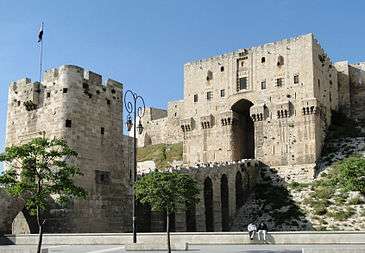
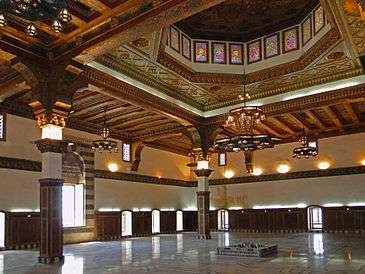
The rulers of Yamhad used the titles of king and Great King, while the Hittite dynasty monarchs used the titles of king and viceroy.
The Emirate of Halab was established in 945 by the Hamdanid dynasty and lasted until 1086, when it became a sultanate under the Seljuq dynasty. The sultanate was sometimes ruled together with Damascus under the same sultan.
The Artuqids rulers used the titles of Malik and emir, as did the Zengid rulers which added the title atabeg. The Ayyubid monarchs used the titles of sultan and malik.
The dates for Yamhad and the Hittite Dynasties are proximate and calculated by the Middle chronology.
Yamhad Dynasty
Yamhad was the name of the Amorite kingdom centered at Ḥalab (modern day Aleppo),[4] its dynasty ruled for more than two centuries, Aleppo became a major power and dominated Northern Syria with the monarch holding the title of Great King.[5][6]
| Portrait | Name | King From | King Until | Relationship with Predecessor(s) | Title |
|---|---|---|---|---|---|
| Sumu-Epuh | c. 1810 BC | c. 1780 BC | King of Yamhad (Halab) | ||
| Yarim-Lim I | c. 1780 BC | c. 1764 BC | • Son of Sumu-Epuh | Great King of Yamhad (Halab) | |
| Hammurabi I | c. 1764 BC | c. 1750 BC | • Son of Yarim-Lim I | Great King of Yamhad (Halab) | |
 |
Abba-El I | c. 1750 BC | c. 1720 BC | • Son of Hammurabi I | Great King of Yamhad (Halab) |
 |
Yarim-Lim II | c. 1720 BC | c. 1700 BC | • Son of Abba-El I | Great King of Yamhad (Halab) |
 |
Niqmi-Epuh | c. 1700 BC | c. 1675 BC | • Son of Yarim-Lim II | Great King of Yamhad (Halab) |
| Irkabtum | c. 1675 BC | Middle 17th century BC | • Son of Niqmi-Epuh | Great King of Yamhad (Halab) | |
| Hammurabi II | Middle 17th century BC | Middle 17th century BC | Great King of Yamhad (Halab) | ||
| Yarim-Lim III | Middle 17th century BC | c. 1625 BC | • Probably Son of Niqmi-Epuh | Great King of Yamhad (Halab) | |
| Hammurabi III | c. 1625 BC | c. 1600 BC | • Son of Yarim-Lim III | King of Yamhad (Halab) |
Aleppo was conquered by Mursili I King of the Hittites, who captured Hammurabi III, the dynasty regained Halab after the assassination of Mursili but the "Yamhad" name fell out of use.[7]
| Portrait | Name | King From | King Until | Relationship with Predecessor(s) | Title |
|---|---|---|---|---|---|
| Sarra-El | Early 16th century BC | Middle 16th century BC | • Probably Son of Yarim-Lim III | King of Halab | |
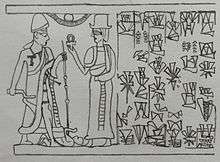 |
Abba-El II | Middle 16th century BC | Middle 16th century BC | • Son of Sarra-El | King of Halab |
| Ilim-Ilimma I | Middle 16th century BC | c. 1525 BC | • Son of Abba-El II | King of Halab |
Hittite Dynasty
Parshatatar of Mitanni conquered Aleppo, and the city became part of that kingdom until conquered by Suppiluliuma I of the Hittites in the 14th century BC. Suppiluliuma installed his son Telipinus as king of Aleppo. Not all the kings of this dynasty are known. The Hittite dynasty remained in power until the Late Bronze Age collapse.[8][9][10]
| Portrait | Name | King From | King Until | Relationship with Predecessor(s) | Title |
|---|---|---|---|---|---|
| Telepinus | Later Half of the 14th century BC | • Son of the Hittite king Suppiluliuma I | King of Halab | ||
 |
Talmi-Sarruma | c. 1300 BC | • Son of Telepinus | King of Halab | |
| Halpazitis | c. 1220 BC | King of Halab |
After the end of the Hittites, Arameans tribes began to settle in the region,[11] Aleppo became part of the Syro-Hittite state of Palistin,[12] then its successor Bit Agusi centered at Arpad,[13] Afterwards, it was sequentially part of Assyria,[14] Chaldea,[15] Achaemenid Persia,[16] Macedonia,[17] Seleúkeia,[18] Armenia,[19] Roman,[20] Byzantine,[21] and Sasanid Persian,[22] empires, the Rashidun,[23] Umayyad,[24] and the Abbasid Caliphate.[25]
Hamdanid Dynasty
The Hamdanids were an Arab dynasty, established in 945 by Sayf al-Dawla, third of the dynasty.[26] They ruled most of Syria, displacing the Ikhshids, with Aleppo as their capital,[27] under the titular authority of the Abbasid Caliph.[28]
| Portrait | Epithet | Name | Emir From | Emir Until | Relationship with Predecessor(s) | Title |
|---|---|---|---|---|---|---|
 |
Sayf al-Dawla | Ali ibn Abu'l-Hayja 'Abdallah (Ali I) | 945 | 967 | Emir of Halab | |
| Sa'd al-Dawla | Sharif ibn Ali (Sharif I) | 967 | 969 | • Son of Sayf al-Dawla | Emir of Halab |
Non-dynastic
Qarghuyah, the chamberlain of Sayf al-Dawla, ousted Sa'd al-Dawla and assumed control over the city. Sa'd al-Dawla was able to regain Aleppo in 977.[28][29]
| Portrait | Epithet | Name | Emir From | Emir Until | Relationship with Predecessor(s) | Title |
|---|---|---|---|---|---|---|
| Qarghuyah | 969 | 975 | Emir of Halab | |||
| Bakjur | 975 | 977 | Emir of Halab |
Hamdanid Dynasty restored
| Portrait | Epithet | Name | Emir From | Emir Until | Relationship with Predecessor(s) | Title |
|---|---|---|---|---|---|---|
| Sa'd al-Dawla | Sharif ibn Ali (Sharif I) | 977 | 991 | • Son of Sayf al-Dawla | Emir of Halab | |
| Sa'id al-Dawla | Sa'id ibn Sharif (Sa'id) | 991 | 1002 | • Son of Sa'd al-Dawla | Emir of Halab | |
| Abu'l-Hasan Ali (Ali II) | 1002 | 1004 | • Son of Sa'id al-Dawla | Emir of Halab | ||
| Abu'l-Ma'ali Sharif (Sharif II) | 1004 | 1004 | • Son of Sa'id al-Dawla | Emir of Halab |
Lu'lu' Dynasty
Lu'lu' al-Kabir was a slave and then chamberlain of Sa'd al-Dawla. He married his daughter to Sa'id al-Dawla, and after the latter's death, he assumed direct power over Aleppo. At first, he served as guardians to Sa'id al-Dawla's sons Abu'l-Hasan Ali and Abu'l-Ma'ali Sharif. In 1004, he had them exiled to Egypt and assumed full control of the city..[30]
| Portrait | Epithet | Name | Emir From | Emir Until | Relationship with Predecessor(s) | Title |
|---|---|---|---|---|---|---|
| Lu'lu' al-Kabir | Abu Muhammad Lu'lu' al-Sayfi (Lu'lu') | 1004 | 1009 | • Sa'id al-Dawla Father in Law | Emir of Halab | |
| Murtada al-Dawla | Abu Nasr Mansur (Mansur) | 1009 | 1016 | • Son of Lu'lu' | Emir of Halab |
Non-dynastic
In 1016, a rebellion broke out in the city and Fath al-Qal'i, custodian of the Citadel of Aleppo, opened the doors for the rebels causing Mansur to flee. Fath accepted the authority of the Fatimid Caliph and, after a brief rule, ceded Aleppo to the caliph in return for the treasury and the rule of Tyre.[31]
| Portrait | Epithet | Name | Emir From | Emir Until | Relationship with Predecessor(s) | Title |
|---|---|---|---|---|---|---|
| Mubarak al-Dawla | Abu Nasr Fath al-Qal'i (Fateh) | 1016 | 1016 | Emir of Halab |
Fatimid Caliphate
Al-Hakim appointed Aziz al-Dawla as the first Fatimid governor of Aleppo, but in 1020, Aziz declared his independence, and ruled for two years before being assassinated by a Fatimid agent.[31]
| Portrait | Epithet | Name | Emir From | Emir Until | Relationship with Predecessor(s) | Title |
|---|---|---|---|---|---|---|
| Aziz al-Dawla | Abu Shuja' Fatik | October 1016 | 6 July 1022 | Emir of Halab | ||
| Wafiyy al-Dawla | Abu'l Najm Badr | July 1022 | October 1022 | Ghulam (slave soldier) of Aziz al-Dawla | Emir of Halab | |
| Safiyy al-Dawla | Muhammad ibn Ali ibn Ja'far ibn Fallah | 10 October 1022 | 10 April 1023 | Emir of Halab | ||
| Sanad al-Dawla | Al-Hasan ibn Muhammad ibn Thu'ban | 10 April 1023 | 2 July 1024 | Emir of Halab | ||
| Sadid al-Mulk | Thu'ban ibn Muhammad ibn Thu'ban | 27 July 1024 | 18 January 1025 | Brother of Sanad al-Dawla | Emir of Halab |
Mirdasid Dynasty
The Mirdasids conquered Aleppo in 1024 and kept their autonomy through political maneuvers, allying themselves with the Byzantines at times and the Fatimid at others.[31]
| Portrait | Epithet | Name | Emir From | Emir Until | Relationship with Predecessor(s) | Notes | Title |
|---|---|---|---|---|---|---|---|
| Asad al-Dawla | Salih ibn Mirdas (Salih) | 1024 | 1029 | Emir of Halab | |||
| Mu'izz al-Dawla | Thimal | 1029 | 1030 | • Son of Asad al-Dawla Salih | First Reign | Emir of Halab | |
| Shibl al-Dawla | Nasr (Nasr I) | 1029 | 1038 | • Eldest son of Asad al-Dawla Salih | Second Reign | Emir of Halab | |
| Mu'izz al-Dawla | Thimal | 1038 | 1038 | • Son of Asad al-Dawla Salih | Second Reign | Emir of Halab |
After the death of Salih, his sons Nasr and Thimal ruled together. In 1030, Nasr deposed Thimal and ruled solely until killed by Anushtakin al-Dizbari, the Fatimid governor of Damascus. Thimal regained Aleppo briefly in 1038 when the Fatimid army retook the city, returning it to Fatimid rule.[31]
Non-dynastic
In December 1041 Anushtakin al-Dizbari fell out of favor with Cairo and declared his independence in Aleppo. He died of illness in 1042 and Thimal returned to power.[31]
| Portrait | Epithet | Name | Emir From | Emir Until | Relationship with Predecessor(s) | Notes | Title |
|---|---|---|---|---|---|---|---|
| Sharaf al-Ma'ali | Anushtakin al-Dizbari | 1038 | 1042 | Emir of Halab |
Mirdasid Dynasty
Thimal regained Aleppo and accepted the authority of the Fatimid Caliph.[31]
| Portrait | Epithet | Name | Emir From | Emir Until | Relationship with Predecessor(s) | Notes | Title |
|---|---|---|---|---|---|---|---|
| Mu'izz al-Dawla | Thimal | 1042 | 1057 | • Son of Asad al-Dawla Salih | Third Reign | Emir of Halab |
Non-dynastic
In 1057, fearing family intrigues, Thimal handed over Aleppo to the Fatimids in return for Acre, Byblos and Beirut, thus returning Aleppo to direct Fatimid control.[31]
| Portrait | Epithet | Name | Emir From | Emir Until | Relationship with Predecessor(s) | Notes | Title |
|---|---|---|---|---|---|---|---|
| Makin al-Dawla | Al-Ḥasan ibn ʿAlī ibn Mulhim al-Uqayli | 1057 | 1060 | Emir of Halab |
Mirdasid dynasty
In 1060, Thimal's nephew, Rashid al-Dawla Mahmud, the son of Shibl al-Dawla Nasr, briefly regained Aleppo, losing after a few months to the Fatimids.[31]
| Portrait | Epithet | Name | Emir From | Emir Until | Relationship with Predecessor(s) | Notes | Title |
|---|---|---|---|---|---|---|---|
| Rashid al-Dawla | Mahmud (Mahmud I) | 1060 | 1060 | • Son of Shibl al-Dawla Nasr | First Reign | Emir of Halab |
About three weeks later on 30 August 1060 Asad al-Dawla 'Atiyya son of Salih the founder of the dynasty occupied Aleppo for a day and a half then fled as Mu'izz al-Dawla Mahmud advanced on the city after defeating the Fatimid army.[31]
| Portrait | Epithet | Name | Emir From | Emir Until | Relationship with Predecessor(s) | Notes | Title |
|---|---|---|---|---|---|---|---|
| Asad al-Dawla | 'Atiyya | 1060 | 1060 | • Son of Asad al-Dawla Salih | First Reign | Emir of Halab | |
| Rashid al-Dawla | Mahmud (Mahmud I) | 1060 | 1061 | • Son of Shibl al-Dawla Nasr | Second Reign | Emir of Halab | |
| Mu'izz al-Dawla | Thimal | 1061 | 1062 | • Son of Asad al-Dawla Salih | Fourth Reign | Emir of Halab | |
| Asad al-Dawla | 'Atiyya | 1062 | 1065 | • Son of Asad al-Dawla Salih | Second Reign | Emir of Halab | |
| Mu'izz al-Dawla | Mahmud (Mahmud I) | 1065 | 1075 | • Son of Shibl al-Dawla Nasr | Third Reign | Emir of Halab | |
| Jalal al-Dawla | Nasr (Nasr II) | 1075 | 1076 | • Son of Rashid al-Dawla Mahmud | Emir of Halab | ||
| Sabiq ibn Mahmud (Sabiq) | 1076 | 1080 | • Son of Rashid al-Dawla Mahmud | Emir of Halab |
Uqaylid Dynasty
The pressure of Tutush I led the people of Aleppo along with the Mirdasid Emir to offer the city keys to Sharaf al-Dawla Muslim the ruler of Mosul, the Mirdasid family members were compensated by various towns in Syria.[32]
| Portrait | Epithet | Name | Emir From | Emir Until | Relationship with Predecessor(s) | Title |
|---|---|---|---|---|---|---|
| Sharaf al-Dawla | Muslim ibn Quraysh (Muslim) | 1080 | 1085 | Emir of Halab |
Sharaf al-Dawla was killed in June 1085 and was succeeded by his brother Ibrahim ibn Quraysh in Mosul, while Halab was Managed by the Sharif Hassan ibn Hibat Allah Al-Hutayti.
Seljuq Dynasty
Hassan ibn Hibat Allah Al-Hutayti promised to surrender the city to Tutush but then refused and wrote to Sultan Malik-Shah I offering to surrender the city to him, Tutush attacked and occupied the city except for the citadel in May 1086, he stayed until October and left for Damascus due to the advance of Malik-Shah armies, the Sultan himself arrived in December 1086.[31]
| Portrait | Epithet | Name | Sultan From | Sultan Until | Relationship with Predecessor(s) | Notes | Title |
|---|---|---|---|---|---|---|---|
| Taj al-Dawla | Tutush | 1086 | 1086 | First Reign | Sultan of Halab | ||
 |
Mu'izz al-Dunia wa al-Din | Malik-Shah | 1086 | 1092 | • Brother of Tutush | Sultan of Halab |
After the death of Malik-Shah I, his governor Aq Sunqur al-Hajib enjoyed much autonomy. He pledged allegiance to Malik-Shah's son Mahmud I, and then to Tutush only to switch back to Mahmud's brother Barkiyaruq. In 1094, Tutush defeated and beheaded Aq Sunqur thus assuming full control over Aleppo.[31]
| Portrait | Epithet | Name | Sultan From | Sultan Until | Relationship with Predecessor(s) | Notes | Title |
|---|---|---|---|---|---|---|---|
| Nasir al-Din | Mahmud (Mahmud II) | 1092 | 1093 | • Son of Malik-Shah | Sultan of Halab | ||
| Taj al-Dawla | Tutush | 1093 | 1093 | • Brother of Malik-Shah | Second Reign | Sultan of Halab | |
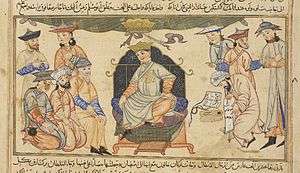 |
Rukn al-Din | Barkiyaruq | 1093 | 1094 | • Son of Malik-Shah | Sultan of Halab | |
| Taj al-Dawla | Tutush | 1094 | 1095 | • Brother of Malik-Shah | Third Reign | Sultan of Halab | |
| Fakhr al-Mulk | Radwan | 1095 | 1113 | • Son of Tutush | Sultan of Halab | ||
| Shams al-Mulk | Alp Arslan | 1113 | 1114 | • Son of Radwan | Under the regency of Lu'lu' al-Yaya | Sultan of Halab | |
| Sultan Shah | 1114 | 1117 | • Son of Radwan | Under the regency of Lu'lu' al-Yaya | Sultan of Halab |
Artuqid Dynasty
Sultan Shah was only six when he came to the throne, the threats of the Crusader Count Joscelin led Sultan Shah Guardian Ibn al-Khashshab to offer the city to Ilghazi of Mardin who came to Aleppo thus starting the Artuqid dynasty in Aleppo.[31]
| Portrait | Epithet | Name | Emir From | Emir Until | Relationship with Predecessor(s) | Notes | Title |
|---|---|---|---|---|---|---|---|
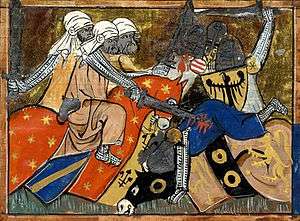 |
Najm al-Din | Ilghazi | 1117 | 1120 | • Son in Law of Radwan | First Reign | Emir of Halab |
| Shams al-Dawla | Suleiman I | 1120 | 1120 | • Son of Ilghazi | Usurper | Emir of Halab | |
| Najm al-Din | Ilghazi | 1120 | 1122 | • Son in Law of Radwan | Second Reign | Emir of Halab | |
| Badr al-Dawla | Suleiman II | 1122 | 1123 | • Nephew of Ilghazi | First Reign | Emir of Halab | |
| Nour al-Dawla | Balak | 1123 | 1124 | • Nephew of Ilghazi | Emir of Halab | ||
| Husam al-Din | Timurtash | 1124 | 1125 | • Son of Ilghazi | Emir of Halab |
Timurtash was occupied with taking over the cities of his recently deceased brother Suleiman I (who usurped the emir of Aleppo briefly in 1120), the crusaders attacked Aleppo but Timurtash refused to come back, this led the people of Aleppo to seek the help of Aqsunqur al-Bursuqi the Seljuq atabeg of Mosul, Aqsunqur broke the crusader siege adding Aleppo to the domains of Seljuq sultan Mahmud II.[31]
In 1127 The city rebelled against the Seljuq governor Khatlagh Abah and restored Suleiman II.
| Portrait | Epithet | Name | Emir From | Emir Until | Relationship with Predecessor(s) | Notes | Title |
|---|---|---|---|---|---|---|---|
| Badr al-Dawla | Suleiman II | 1127 | 1128 | • Nephew of Ilghazi | Second Reign | Emir of Halab |
Zengid Dynasty
Imad ad-Din Zengi, the new atabeg of Mosul, sent his army to end the troubles. He ruled in the name of Seljuq Sultan Mahmud II whose death had led to civil war. Zengi didn't declare his independence and stood by Ghiyath ad-Din Mas'ud. the Seljuq Sultan of Iraq, ruling in his name. However, the sultan decided to eliminate Zengi and called upon him to show in his presence. Zengi was warned and declined to show thus establishing his independence.[31]
| Portrait | Epithet | Name | Atabeg From | Atabeg Until | Relationship with Predecessor(s) | Notes | Title |
|---|---|---|---|---|---|---|---|
| Imad al-Din | Zengi I | 1135 | 1137 | • Son in Law of Radwan | Effective Reign 1128-1146 | Atabeg of Halab |
Zengi reconciled with the sultan and recognized his authority, but in practice he was independent in all but name.[31]
When Nur ad-Din inherited Aleppo after father's murder, he took the title of King (Malik) and used the title of Emir.[33] Formally, the Zengids were subordinate to the Seljuq Sultans of Iraq, firstly Mas'ud then Malik-Shah III followed by Muhammad II. Nur al-Din retained the title of atabeg although he was completely independent as the Seljuq empire disintegrated after 1156,[34] and the sultans had to fight in Iraq to keep whats left of their authority. Muhammad II was the last Sultan to hold any real authority, and he attacked Baghdad aided by Nur al-Din's brother Qutb ad-Din Mawdud. Muhammad II death in 1159 and the fact that his successor Suleiman-Shah was a captive of Mawdud ended any real authority of the Seljuq Sultans,[35] Nur al-Din Held the Khutbah in the name of the Abbasid Caliph,[36] an enemy of the Seljuqs thus cutting any links with them.
| Portrait | Epithet | Name | Emir From | Emir Until | Relationship with Predecessor(s) | Notes | Title |
|---|---|---|---|---|---|---|---|
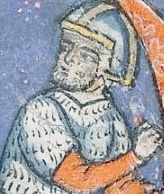 |
Nur al-Din | Mahmud (Mahmud III) | 1146 | 1174 | • Son of Zengi I | Also Emir of Damascus | Emir of Halab |
| Al-Salih | Ismail | 1174 | 1181 | • Son of Nur al-Din Mahmud | King of Halab | ||
| Izz al-Din | Mas'ud | 1181 | 1182 | • Grandson of Zengi I | Emir of Halab | ||
| Imad al-Din | Zengi II | 1182 | 1183 | • Brother of 'Izz al-Din Mas'ud | Emir of Halab |
Ayyubid Dynasty
The death of Nur al-Din caused chaos as al-Salih Ismail al-Malik, his son and successor was only eleven. The Zengid governors fought for power, each one of them trying to be the atabeg of al-Salih. One of them, Gümüshtegin, became the guardian of the young king and tried to eliminate the others causing the governor of Damascus to ask Saladin, the Zengid governor of Egypt, for help. Saladin, formally a subordinate to Al-Salih but practically independent, marched on Syria entering Damascus in November 1174. He besieged Aleppo, causing Al-Salih's cousin Ghazi II the Emir of Mosul to send his army which Saladin defeated at the battle of Tell al-Sultan, Saladin was proclaimed King of Egypt and Syria, the Caliph al-Mustadi conferred the Title of Sultan upon him.[37]
Saladin met al-Salih and concluded a peace with the 13-year old king in 1176 leaving him to rule Aleppo independently for life while he (Saladin) ruled the rest of Syria.[31]
After the death of al-Salih, Saladin expelled al-Salih's relative Zengi II and entered Aleppo on 20 June 1183 thus ending the Zengid Dynasty.
| Portrait | Epithet | Name | Sultan From | Sultan Until | Relationship with Predecessor(s) | Notes | Title |
|---|---|---|---|---|---|---|---|
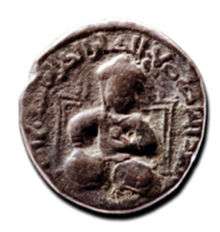 |
Al-Nasir Salah al-Din | Yusuf I | 1183 | 1193 | • Married Mahmud III Widow | Sultan of Halab | |
 |
Al-Zahir | Ghazi | 1193 | 1216 | • Son of Salah al-Din | Sultan of Halab | |
| Al-Aziz | Muhammad | 1216 | 1236 | • Son of Al-Zahir Ghazi | Sultan of Halab | ||
| AL-Nasir | Yusuf II | 1236 | 1260 | • Son of Al-Aziz | Regency of Dayfa Khatun, Also Sultan of Damascus | Sultan of Halab |
On 24 January 1260 the Mongol Khan Hulagu Khan entered Aleppo after a month of Siege thus ending the Ayyubid Dynasty.
Mamluks
The Mamluk Sultan Qutuz defeated the Mongols at Ain Jalut on 3 September 1260,[38] the whole of Syria became part of the Mamluk Sultanate, Aleppo was the capital of its own province ruled by a Na'ib (Naib), some of these governors revolted and declared their independence in Aleppo like Shams al-Din Aqosh al-Borli who installed al-Hakim I as Abbasid Caliph in order to legitimize his reign while the Sultan Baibars I installed al-Mustansir II,[39] other governors revolted with the aim of ruling the whole sultanate such as Yalbogha al-Nasiri who had Sultan Barquq dethroned in 1389.[40]
| Portrait | Epithet | Name | Sultan From | Sultan Until | Notes | Title |
|---|---|---|---|---|---|---|
| Shams al-Din | Aqosh | 1261 | 1261 | Expelled by 'Ala' al-Din al-Bunduqdari General of Baibars I | Sultan of Halab |
Aqosh eventually reconciled with the sultan, in 1404 Sayf al-Din Jakam revolted and declared himself Sultan.[41]
| Portrait | Epithet | Name | Sultan From | Sultan Until | Notes | Title |
|---|---|---|---|---|---|---|
| Sayf al-Din | Jakam | 1404 | 1406 | First Reign : Built the Throne Hall of Aleppo Citadel,[42] Eventually Expelled | Sultan of Halab |
Jakam Reoccupied the City and was pardoned and reappointed by the sultan, in May 1406 he was replaced by another Na'ib leading him to revolt again.
| Portrait | Epithet | Name | Sultan From | Sultan Until | Notes | Title |
|---|---|---|---|---|---|---|
| Sayf al-Din | Jakam | 1407 | 1407 | Second Reign, Beheaded | Sultan of Halab |
See also
- Timeline of Aleppo
- State of Aleppo
- Rulers of Damascus
- List of Emirs of Mosul
References
Citations
- Pettinato, Giovanni (Johns Hopkins University Press, 1991) Ebla, a new look at history p.135
- William J. Hamblin. Warfare in the Ancient Near East to 1600 BC. p. 220.
- John David Hawkins. Inscriptions of the Iron Age: Part 1. p. 388.
- Martin Sicker (2000). The pre-Islamic Middle East (Hardcover ed.). Praeger. p. 26. ISBN 0-275-96890-1.
- Gordon Douglas Young. Ugarit in Retrospect. p. 7.
- Mario Liverani. The Ancient Near East: History, Society and Economy. p. 234.
- Michael C. Astour. Orientalia: Vol. 38. p. 384.
- John David Hawkins. Inscriptions of the Iron Age: Part 1. p. 388.
- P. J. Van Den Hout. The Purity of Kingship. p. 56.
- P. J. Van Den Hout. The Purity of Kingship. p. 59.
- Herbert Niehr. The Aramaeans in Ancient Syria. p. 6.
- Trevor Bryce. Ancient Syria: A Three Thousand Year History. p. 111.
- John Boardman. The Cambridge Ancient History: pt. 1. The prehistory of the Balkans; and the Middle East and the Aegean World. p. 375.
- John Boardman. The Cambridge Ancient History: pt. 1. The prehistory of the Balkans; and the Middle East and the Aegean World. p. 261.
- Trevor Bryce. Ancient Syria: A Three Thousand Year History. p. 138.
- Trevor Bryce. Ancient Syria: A Three Thousand Year History. p. 147.
- Douglas A. Phillips; Charles F. Gritzner. Syria. p. 27.
- Yasser Tabbaa. Constructions of Power and Piety in Medieval Aleppo. p. 16.
- Maurice Sartre. The Middle East Under Rome. p. 28.
- Martin Sicker. Between Rome and Jerusalem: 300 Years of Roman-Judaean Relations. p. 42.
- Philip K Hitti. History of Syria, Including Lebanon and Palestine. p. 351.
- Bradbury, Jim (2004). The Routledge Companion to Medieval Warfare. Routledge. p. 25. ISBN 978-1134598472.
- Tony Jaques. Dictionary of Battles and Sieges: A-E. p. 28.
- James Schryver. Studies in the Archaeology of the Medieval Mediterranean. p. 132.
- Philip K Hitti. History of Syria, Including Lebanon and Palestine. p. 534.
- Hugh Kennedy. Warfare and Poetry in the Middle East. p. 168.
- Trudy Ring; Robert M. Salkin; Sharon La Boda. International Dictionary of Historic Places: Middle East and Africa, Volume 4. p. 46.
- Josef W. Meri. Medieval Islamic Civilization. p. 313.
- John Bagnell Bury. The Cambridge medieval history, Volume 5. p. 250.
- C.E. Bosworth; E. Van Donzel. The Encyclopaedia of Islam. p. 820.
- Kamāl al-Dīn ʻUmar ibn Aḥmad Ibn al-ʻAdīm. Zubdat al-ḥalab min tārīkh Ḥalab.
- Clifford Edmund Bosworth. The New Islamic Dynasties: A Chronological and Genealogical Manual. p. 67.
- Thomas Asbridge. The Crusades: The War for the Holy Land. p. 1141.
- Helen Nicholson; David Nicolle. God's Warriors: Knights Templar, Saracens and the Battle for Jerusalem. p. 91.
- J. A. Boyle. The Cambridge History of Iran, Volume 5. p. 176.
- Jonathan M. Bloom. Arts of the City Victorious: Islamic art and architecture in Fatimid North Africa and Egypt. p. 175.
- Josef W. Meri. Medieval Islamic Civilization. p. 690.
- Read, Piers Paul (1999). The Templars. Weidenfeld & Nicolson. p. 229. ISBN 9780297842675.
- ʻAbbās, Iḥsān (1998). Tārīḫ bilād aš-Šām fī ʻaṣr al-mamālīk 648-923h., 1250-1517m. Matbaʻat al-Ǧāmiʻa al-Urdunnīya. p. 400.
- Petry, Carl F. (10 July 2008). The Cambridge History of Egypt. 1. Cambridge University Press. p. 291. ISBN 9780521068857.
- Cattermole, Paul (2008). Architectural Excellence: 500 Iconic Buildings. Firefly Books. p. 73. ISBN 9781554073580.
- Bosworth, Clifford Edmund (2004). The New Islamic Dynasties: A Chronological and Genealogical Manual. Edinburgh University Press. p. 77. ISBN 9780748621378.
